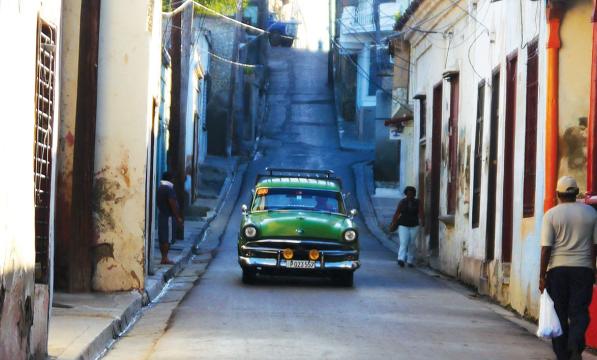A two-week cycle tour of Cuba

We’re dirty, exhausted and in the middle of nowhere, but we’re met by shaking heads. We try again in our limited Spanish: ‘Five people. One night. Here. For tourists. Yes?’ It doesn’t work. ‘No’ and ‘nacionalidad’ is about all we understand – just enough for us to glean that Brits are not welcome at this campismo (a basic beachside resort where Cubans are allowed by the state to go on holiday).
It was the second day of our two-week cycle tour around Cuba. We had arrived at the Rio Carbonico campismo at the end of a hot 110km ride, with sunset half an hour off. The chance of getting to the next village 20km away was slim.
Just then an onlooker intervened and offered us dinner at his house. We followed him to a tiny wooden house, set idyllically into the forest. A wash in the river nearby, a huge plate of rice and chicken, and a few awkward attempts at communicating with the family later, and we were all falling asleep on make-shift beds.
Cuba is a great place for cycle touring. Apart from the stunning scenery, sites of interest, good roads and tolerant drivers, its recent political and economic environment has instilled in its people an ability to ‘mend and make do’. On the one hand, this provided some comfort that if something happened to the bikes (or us), the Cubans would fix it. But moreover, it provided a quiet sense of security. It’d work out.
The cars are a perfect example. At the end of our trip, we found ourselves unable to get a bus to Trinidad so asked after private transport instead. This wasn’t a problem: seven men set about squeezing five bikes into the back of one bright green 1957 Rambler estate.
Half way through the journey, there was a clank from the underside of the vehicle. No problem. The driver stopped, found a local farmer, obtained a piece of string, tied up the car, and delivered us to our destination.
Castro’s hide-out
Our tour began at Holguin, a dusty town that gave us access to Cuba’s eastern region. This is arguably the most spectacular part of the country, offering incredible scenic variety and, as the heartland of the Cuban Revolution, plenty of culture and history. With only one minor interruption, we cycled 756 kilometres to make an almost full loop around the eastern tip of the island.
We took in mountains, coast, lush farmland, and semi-desert scrub, riding into villages, resorts, and old plazas."
We took in mountains, coast, lush farmland, and semi-desert scrubland, passing through tiny hidden-away villages, beachside resorts and towns with characterful plazas. On a bike, you take it all in: the roadside stall offering piles of mouthwatering fruit; the old man with a face like scrunched-up paper, watching the world go by; all the Che Guevara graffiti.
We also stopped for longer breaks after every three days or so on the bikes, punctuating our trip with more usual tourist activities. We stopped off at Baracoa, Santiago de Cuba, Fidel Castro’s mountain hide-out, and the heritage site of Trinidad.
Leaving Baracoa, we faced a 76km ride to Yacabo Abajo, including La Farola, a steep pass over the Sierra del Puriel mountain range, and one of the trip’s highlights. We approached the mountains in the blazing sun. As we ascended, however, the clouds came across, cooling us down and providing a moody backdrop to the deep green forested hills and valleys around us. Then the clouds darkened and, just as Dave was removing a three-inch nail from his front tyre, they burst.
Tropical rain
Torrential doesn’t describe it. As we heaved our way up the last few kilometres, we could hardly see two metres. Yet after the heat of the morning it was deliciously refreshing, a cathartic outpouring that placed smiles of amusement on all our faces.
As quickly as the rain began, it stopped. As we left the mountains behind us, the sun lit up a different landscape – an arid, semi-desert terrain that stretched its way to the sea. It got better the further we journeyed. The stretch from Santiago to Pilon was special: mountains one side, sea the other.
After that we began our second mountain climb. The long, flat option from Pilon to Bartolemé Maso would be easy but boring. So we took the route through the mountains.
It was relentless. There were repeated 25% inclines on unmade roads, and 15 deep fords that we couldn’t cycle across. It took us nearly six hours to travel 20km and climb 1600m, much of it on foot. Yet it was also beautiful. Bright blue and yellow butterflies danced around the trees, which led into a forest so deep that it had once hidden hundreds of revolutionaries.
At the highest point, we could see for miles. We felt utterly removed from the rest of the world. We’d given it a go, the Cuban way, and it had all worked out.
This was first published in the October / November 2014 edition of Cycling UK's Cycle magazine.

